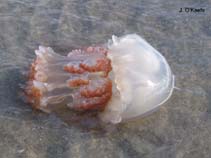Stomolophus meleagris Agassiz, 1862
Cannonball jellyfish| Native range | All suitable habitat | Point map | Year 2050 |

|
| This map was computer-generated and has not yet been reviewed. |
| Stomolophus meleagris AquaMaps Data sources: GBIF OBIS |
Classification / Names Common names | Synonyms | CoL | ITIS | WoRMS
Scyphozoa | Rhizostomeae | Stomolophidae
Environment: milieu / climate zone / depth range / distribution range Ecology
Pelagic; brackish; depth range 0 - 85 m (Ref. 116114). Tropical; 42°N - 30°S, 118°W - 34°W
Distribution Countries | FAO areas | Ecosystems | Occurrences | Introductions
Western Atlantic and Eastern Pacific: Tropical to temperate.
Length at first maturity / Size / Weight / Age
Maturity: Lm 10.5 range ? - ? cm Max length : 18.0 cm WD male/unsexed; (Ref. 2992)
Short description Morphology
Up to 18 cm wide, half egg shaped or almost globular; number of velar lappets variable, about 14 in each octant, grooves between them short, all alike; scapules large, extending to or beyond level of bell margin; the free, bifurcate ends of the mouth-arms flare outwards, the lateral branches long.
Neritic, estuarine, potentially pathogenic (Ref. 116114). Feeds on bivalve veligers, gastropod veligers, copepod eggs, nauplii, copepodites and adults, and Oikopleura sp. (Ref. 106824).
Life cycle and mating behavior Maturity | Reproduction | Spawning | Eggs | Fecundity | Larvae
The fertilized egg develops into a tiny, motile planula larva. After swimming freely in the water for several days, the planula attaches to a suitable substrate and transforms into a sessile polyp or scyphistoma. Scyphistomae feed and grow, attaining a maximum size of a few mm. They reproduce asexually a number of ways, including the formation of podocysts and motile or non-motile buds, but only podocyst. The scyphistoma undergoes strobilation which results to ephyrae; developing itself into medusae.
Main reference
References | Coordinator | Collaborators
Migotto, A.E., A.C. Marques, A.C. Morandini and F.L. da Silveira. 2002. (Ref. 813)
IUCN Red List Status (Ref. 130435)
CITES status (Ref. 108899)
Not Evaluated
CMS (Ref. 116361)
Not Evaluated
Threat to humans
Human uses
Fisheries: commercial
| FishSource |
Tools
More information
Internet sources
BHL | BOLD Systems | CISTI | DiscoverLife | FAO(Publication : search) | Fishipedia | GenBank (genome, nucleotide) | GloBI | Gomexsi | Google Books | Google Scholar | Google | PubMed | Tree of Life | Wikipedia (Go, Search) | Zoological Record
Estimates based on models
Preferred temperature
(Ref. 115969): 20 - 27.9, mean 24.7 (based on 600 cells).
Price category
(Ref. 80766):
Unknown.



